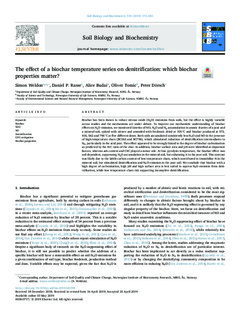| dc.contributor.author | Weldon, Simon | |
| dc.contributor.author | Rasse, Daniel | |
| dc.contributor.author | Budai, Alice | |
| dc.contributor.author | Tomic, Oliver | |
| dc.contributor.author | Dörsch, Peter | |
| dc.date.accessioned | 2020-01-13T12:18:50Z | |
| dc.date.available | 2020-01-13T12:18:50Z | |
| dc.date.created | 2019-05-27T11:15:46Z | |
| dc.date.issued | 2019-05-03 | |
| dc.identifier.citation | Soil Biology and Biochemistry. 2019, 135 173-183. | nb_NO |
| dc.identifier.issn | 0038-0717 | |
| dc.identifier.uri | http://hdl.handle.net/11250/2635967 | |
| dc.description.abstract | Biochar has been shown to reduce nitrous oxide (N2O) emissions from soils, but the effect is highly variable across studies and the mechanisms are under debate. To improve our mechanistic understanding of biochar effects on N2O emission, we monitored kinetics of NO, N2O and N2 accumulation in anoxic slurries of a peat and a mineral soil, spiked with nitrate and amended with feedstock dried at 105 °C and biochar produced at 372, 416, 562 and 796 °C at five different doses. Both soils accumulated consistently less N2O and NO in the presence of high-temperature chars (BC562 and BC796), which stimulated reduction of denitrification intermediates to N2, particularly in the acid peat. This effect appeared to be strongly linked to the degree of biochar carbonisation as predicted by the H:C ratio of the char. In addition, biochar surface area and pH were identified as important factors, whereas ash content and CEC played a minor role. At low pyrolysis temperature, the biochar effect was soil dependent, suppressing N2O accumulation in the mineral soil, but enhancing it in the peat soil. This contrast was likely due to the labile carbon content of low temperature chars, which contributed to immobilise N in the mineral soil, but stimulated denitrification and N2O emission in the peat soil. We conclude that biochar with a high degree of carbonisation, high pH and high surface area is best suited to supress N2O emission from denitrification, while low temperature chars risk supporting incomplete denitrification. | nb_NO |
| dc.language.iso | eng | nb_NO |
| dc.rights | Navngivelse-Ikkekommersiell-DelPåSammeVilkår 4.0 Internasjonal | * |
| dc.rights.uri | http://creativecommons.org/licenses/by-nc-sa/4.0/deed.no | * |
| dc.subject | Biochar | nb_NO |
| dc.subject | N2O | nb_NO |
| dc.subject | NO | nb_NO |
| dc.subject | Denitrification | nb_NO |
| dc.subject | GHG mitigation | nb_NO |
| dc.subject | Biochar properties | nb_NO |
| dc.title | The effect of a biochar temperature series on denitrification: which biochar properties matter? | nb_NO |
| dc.type | Journal article | nb_NO |
| dc.type | Peer reviewed | nb_NO |
| dc.description.version | publishedVersion | nb_NO |
| dc.rights.holder | © 2019 The Authors. Published by Elsevier Ltd. | nb_NO |
| dc.subject.nsi | VDP::Landbruks- og Fiskerifag: 900 | nb_NO |
| dc.source.pagenumber | 173-183 | nb_NO |
| dc.source.volume | 135 | nb_NO |
| dc.source.journal | Soil Biology and Biochemistry | nb_NO |
| dc.identifier.doi | 10.1016/j.soilbio.2019.04.018 | |
| dc.identifier.cristin | 1700398 | |
| dc.relation.project | Norges forskningsråd: 281113 | nb_NO |
| dc.relation.project | Andre: 696356 - FACCE-ERA-GAS | nb_NO |
| cristin.unitcode | 7677,4,0,0 | |
| cristin.unitname | Divisjon for miljø og naturressurser | |
| cristin.ispublished | true | |
| cristin.fulltext | original | |
| cristin.qualitycode | 2 | |

